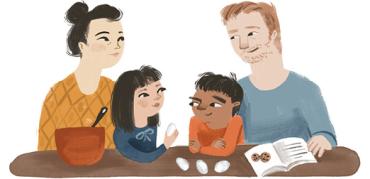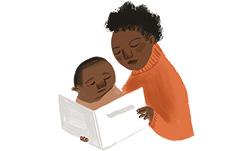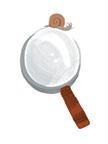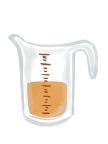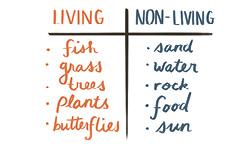Julia invited Marco, her friend from preschool, over to make chocolate chip cookies. “Mmmm,” says Julia, “chocolate chip cookies are my favorite!” “Mine too,” says Marco, “but I’ve never made them before! This will be fun!”
Julia’s parents help the children collect the ingredients and put them on the counter: butter, flour, chocolate chips (“Yay, the best part!” shouts Julia), sugar (“Sugar must be what makes them sweet,” says Marco), and all the rest until Julia’s dad asks Marco to get two eggs from the refrigerator. “Eggs!” says Marco, “I don’t like eggs!” “Well, Marco, we need them, so please take two out.” “Do we need them? I really don’t like eggs! I think they will ruin the cookies—I don’t want to get them.”
Julia’s dad looks at her mom: What to do? Their favorite recipes all call for two eggs. Besides, this is supposed to be a fun Saturday activity, not a battle of wills with a 4-year-old! “Hmmm,” says Julia’s mom, “I have an idea. Your teacher’s last science newsletter said that in class you tested different ways of making play dough. Do you remember that?” “Yes,” says Julia, “that was fun—one turned out soft and one turned out hard!” “Well, let’s try two different ways of making chocolate chip cookies!”
Julia’s dad breaks into a grin: “What a great idea! We can make one batch with eggs and one without eggs. Something else I read in the newsletter was that it is good to make predictions. Julia, which cookies do you predict will be better?” “Dad, how do I know? I’ve never done this before. What do you think?” “I have absolutely no idea! Isn’t that great! We get to try something new and see what happens! Let me go get some paper and a pen—I want to write down everybody’s predictions about how the cookies will turn out.”
A few minutes later, Julia’s dad has written down everyone’s predictions: since Julia can’t taste egg in regular cookies, she thinks there will be no difference (now that she thinks of it, maybe parents just sneak eggs into cookies because parents like kids to eat eggs); Marco says the cookies without eggs will (obviously) taste better than the regular cookies; Julia’s dad says he thinks eggs make the batter fluffy, so the cookies with eggs will be fluffier; and Julia’s mom thinks eggs help to make the cookies soft and moist, so the cookies without eggs will be harder and drier than the cookies with eggs.
Now it’s time to make the cookies: “Marco, you measure the chocolate chips.” And so begins the process of measuring, mixing, and baking.
There are two things to notice in this fictional account of Julia’s home: The first is the scientific thinking that happened (and will happen as the day goes on). A potential showdown with a picky eater was turned into an authentic question (what happens when we remove the eggs from a cookie recipe?), a way to investigate the question was proposed (make one batch with eggs, one batch without), predictions were made, and the practices of mathematical thinking and accurate measuring were used to conduct the cookie-making investigation. We can also imagine them discussing other scientific observations once they try the cookies.
The second thing to notice is that making cookie baking more scientific didn’t make it any less fun—in fact, it made it more fun. All the traditional aspects of cookie baking are present (including the final step of eating the delicious cookies). But there is also a sense of wonder and anticipation as they await the results of the taste test. On a related note, if you are wondering what the differences between the two batches of cookies are, we don’t know—we haven’t conducted this experiment, and this reinforces a point made by Julia’s dad: adults do not need to know the results of a scientific investigation before conducting it. That’s because providing the opportunity for genuine learning to take place, by adults as well as children, is itself a key feature of science.
Turning everyday activities such as baking into scientific activities is more than just fun: it is important for our children’s futures. Science investigations provide an opportunity for children to learn about scientific concepts and listen to their peers, family, and community members, and to respond to their questions or ideas. It also provides them with an opportunity to ask and answer their own questions, build persistence, and improve their problem-solving and self-regulation skills, which are essential for academic success.1
Additionally, as the world becomes increasingly science- and technology-oriented, all children need to become proficient in science, whatever their chosen field. STEM (science, technology, engineering, and math) education has become a national priority, and even early childhood teachers are expected to increase the quantity and quality of the science experiences they provide, particularly for their traditionally underserved students.
In improving early childhood science experiences, parents can be a powerful ally. As we will discuss in this article, simple changes can make everyday activities more scientific—for instance, asking: “Which objects float in the bathtub and which don’t? Why might that be?” Or “Which glass holds more water—the tall, thin one or the short, wide one? How can we tell?” Or “While we are at the zoo today, let’s think about some of the things that are similar among all plant eaters and some of the things that are different.”
Parents’ Attitudes about Science Learning
A recent national study, What Parents Talk about When They Talk about Learning: A National Survey about Young Children and Science,* which we published in March 2018, uncovers parents’ beliefs and attitudes about science and gives teachers a place to start in making home-school science connections. For the study, we spoke with more than 1,400 parents and caregivers of children ages 3 to 6 across the country with diverse economic situations and educational backgrounds. Key findings include:
Almost all parents are invested in their children’s learning, but many feel that science is less important to support at home than literacy and social skills development.
Parents need to know about the increasing importance of science in children’s lives and how they can help to develop their children’s attitudes toward science, regardless of age. They also need to know that people in different careers and of different ethnicities and cultures engage in scientific practices, and that science isn’t about memorizing dry facts but is about communicating ideas, reading both nonfiction and science-based fiction, writing notes and logs and drawing pictures, and investigating a scientific topic to learn more. The national study found that many parents base their ideas on what kinds of learning they should foster at home on their perceptions of teacher expectations, so making those expectations clear could have an impact on parental support of science at home.
Fewer parents feel “very confident” in their ability to support their children’s science learning than in other areas.
Parents report not knowing much about science and feeling unprepared to answer their children’s science-related questions. Parents should know that science is not about being “correct,” but is an active process that includes exploring, observing, offering plausible ideas, and proposing solutions to problems. As in the cookie-baking example above, posing a question and investigating it is a deeply scientific activity. So is taking a nature walk and trying to classify the different types of plants, insects, and animals that you see.
More than half of parents report engaging their children in science-related learning activities daily.
Although they are sometimes unsure about how these activities relate to science, many parents already engage their children in exploring outdoors, in cooking and building activities, in using science-related videos and digital games, and in reading science-related books. This is exciting news for early childhood teachers, who may find it challenging to engage parents in supporting children’s school learning. Parents need guidance on making connections to classroom science topics (for example, looking at plant parts). Making these connections explicit can reinforce for parents the need to explore science with their children at home and can also encourage them to do more.
Among the study’s other key findings is that 7 out of 10 parents say that knowing what young children need to learn about science, and having ideas for doing science with everyday materials, would help them do a lot more science at home. They just lack ideas for simple activities they can do at home.
And while most parents state that their children use science media (TV shows, videos, games, apps, and websites) at least weekly, and that they, as parents, monitor their children’s media use, fewer parents make connections between the science in the media and the science their children do at home and in school.
Later, we offer specific recommendations for early childhood educators to help families increase children’s engagement in scientific practices. But first, we discuss what it means to teach science in the early education classroom.
Science in Early Childhood Classrooms
As an early childhood educator, you likely feel pressure to achieve what can sometimes seem impossible, such as finding time to do more science activities in your classroom. Early childhood education standards2 have a full plate of requirements (including science) that you may have a hard time including in your busy classroom schedule. Contributing to this tension might also be the lingering notion that early childhood settings are not the place for science-based instruction. Additionally, many early childhood educators have had a limited amount of professional development specific to science.3
There is no doubt about it—early childhood standards do have a lot of requirements, especially if each area is considered to be something taught independent of the rest of the standards. Fortunately, there are ways to include meaningful science education activities that build on, instead of detract from, activities preschool children do already. And we’re sure that many early childhood educators are successfully finding creative ways to do this.
Science allows children to wonder, to make predictions based on that wonderment (while also integrating their past experiences), and to test out and refine those predictions. Examples of what makes an activity “scientific” include things such as questioning which ramp will make a ball roll toward a target faster, or what conditions are best for growing a plant. The important key to this is asking investigable questions and providing rich opportunities for those investigations to occur.
It is also crucial that children be allowed to take the lead. And while they make observations and figure out the best way to record the results, teachers and parents can follow up by asking questions such as “What if ... ?” and “Why do you think that?” For example, “What if we covered the ramps in bubble wrap: Would the balls roll faster or slower? Why do you think that?” Or “What if we changed the slime recipe to have more water: Would it be more or less stretchy? Why do you think that?” Remember that it is not important for anyone (including you, as the teacher) to make correct predictions, to conduct neat and tidy investigations, or to know the “right answer.” Instead, the essential component is that the children and adults guiding them embark on the process of investigating together; asking questions, collaborating, sharing tools, revising thinking based on results, and enjoying the journey.
We know the value that parents place on the development of their children’s literacy skills, and science activities can provide the foundation for explorations that spill over into early literacy activities. Children benefit from the ability to construct knowledge and develop reading and writing skills through a range of experiences, topics, and purposes, and science activities can provide natural opportunities for practicing these skills.4 Children can read or look at images that provide factual information about the ocean or weather, and they can document what they see through drawings and writing. These “informational texts” differ from narrative texts that tell a story. Informational texts can be used for posing questions (“What birds can we expect to see in our area?”) and for answering students’ questions (“Do all insects have six legs? Are spiders insects?”).
As early childhood educators know, and as we have tried to make clear, science need not be a formal experience in a laboratory. Our world is made up of the human-made and natural environment, and these contexts provide countless jumping-off points for your students to explore and develop scientific inquiry skills. Armed with a digital camera or a photo-capturing app like Photo Stuff with Ruff (available for free on the PBS Kids app), along with a piece of wood, cardboard, or plastic disguised as a ramp, or a mixture of dirt, leaves, and bugs, educators can continue to support a broad set of learning goals while providing children with engaging and developmentally appropriate science activities that are set within children’s everyday experiences and environments.
And perhaps just as importantly, as early childhood teachers, you also have the powerful ability of helping parents engage their children in these activities. Either via a quick conversation at pickup or a short weekly newsletter sent home to parents (either digitally or on paper), something similar to the below exchange can be all the impetus parents need to get started on their own scientific journey with their children:
We’re exploring water in class this week; the children were excited to take turns at the water table, pouring water into different sized and shaped containers, and predicting what familiar objects from around the classroom would sink to the bottom or float to the top. It was something that I enjoyed learning about, too! I didn’t always know how the investigations would turn out, but the children and I figured it out and learned together! It’s something that you can explore at home, too—for example, at bath time or while in the kitchen washing dishes after dinner.
Ways to Connect Science Learning at School and Home
To bridge the gap between the early childhood classroom and home, educators can find and highlight content areas and activities that are accessible at home, promote and support more science-based discussions at home, and encourage at-home science activities.
When connecting science learning at school with experiences at home, we suggest that educators:
- Choose topics in the classroom that children can explore in school and at home. Moreover, consider phenomena they are likely to see and experience in their daily lives and communities.
- Provide parents with ideas for activities they can do with their children that don’t require special materials or a lot of time. For example, give parents tip sheets with conversation starters and ideas for science activities while walking to school or while at the grocery store. Consider media-based resource suggestions. Send home a newsletter that tells parents about science activities that were done in the classroom and that can be easily duplicated and/or extended at home.
- Encourage conversations between children and their parents, siblings, and grandparents to explore the science in their communities—for example, send children home with activities that require them to talk with their families about the current science activities they are doing in school.
- Make a particular effort to connect with families who have less formal education, who may feel particularly insecure about being “wrong,” and who may need more resources and encouragement. Let families know about inexpensive science activities they can do at home or in their neighborhood with common everyday items, like using a piece of cardboard to create a ramp or bringing household objects to the bathtub to predict if they will sink or float.
Science Activities and Resources to Consider
Outdoor Exploration and Classification
Many parents need help connecting home activities with the science their children are doing in school, and life science provides a perfect vehicle for making this connection. Children already explore aspects of life science in their class—for example, studying the differences between living and nonliving things—and you can help parents continue that exploration when children are in their home communities. A fun activity to encourage parents to do with their children is to document on a t-chart the different living and nonliving things they see and encounter on their way home from school and/or over the weekend.
This simple activity allows children (and their parents) to understand life science content through the use of science practices, including observing different living and nonliving things, comparing those things, documenting what was found, and sharing and discussing those discoveries with peers and adults. To really help children experience the home-school science connection, this activity can be expanded by creating a larger t-chart in the classroom that includes all the children’s findings.
Next, children can sort the different living and nonliving things into other categories. For example, the living things can be sorted into plants, animals, and insects, and the nonliving things can be sorted according to their use or where they came from. To help parents with ideas on additional science activities, you can send students home with a note about a living thing they expressed interest in learning more about, including some suggested resources (e.g., specific books or websites) for families to research and learn from together.
Question Jars
Another way to connect home and school, while reinforcing the idea that adults don’t need to have the right answer, is to set up a question jar in your classroom and have children create one for use at home as well. The purpose of the jar is to write down questions that arise during the day or week—for example, “Why is the sky blue?” “Do trees breathe?” “How do fish live underwater?” Parents can write down questions their children ask and add them to the jar at home. Every month or so, you can suggest that parents and children choose one question to research and answer together. You might even want to provide parents with some suggested resources and guidance on how to try and answer the question—for example, helpful websites to consult, like Encyclopedia Britannica or National Geographic. To ensure that the activity engages children and parents in science practices, encourage parents to help their children make predictions before answering the question. Doing so can also serve as a model for other home activities (as seen in the cookie scenario at the beginning of this article).
Literacy and Science
We know that parents already engage their children in literacy activities. Help them connect literacy and science by encouraging parents and children to record their question jar findings using either words or images in a “science journal” or notebook, where they can see all the questions they’ve answered from their jar throughout the year. To make a clear connection between the classroom and home, children can answer questions from the classroom jar as a classroom activity and include them in the same journal. This science journal can also serve as the basis for encouraging science-related discussions between parents and children: parents can look at the journal entries from school and ask their children to talk about them. Through this exercise, parents can learn that even the teacher doesn’t always know the answer, and that that’s OK! It also allows parents to see that science is not about technical jargon but is related to things they talk about and do in their everyday lives. Finally, activities such as these help parents understand that science is rooted in and stems from exploration and curiosity, and so by engaging and supporting their children’s innate curiosity, they are supporting science learning.
Connect to Classroom Routines
Another way to encourage home discussions and provide simple home activities is to have parents ask their children to perform classroom jobs (e.g., feeding the pet, watering the plants) at home, to encourage making connections to science. For example, some of you may incorporate the weather as part of your daily morning meeting or circle time during class. If you’ve assigned some of your children the job of “weather reporter” for a given week, they can be sent home with a weather card to fill out with their parents over the weekend. Each card can include prompts that ask the children (with their parents’ help) to record the weather (Is it sunny? Is it raining? Is it cloudy?), as well as other weather-related observations (What do you see? What do you hear? What do you feel? What types of clothing are people wearing and why?) and what activities they did over the weekend based on the weather.
Connect to Holidays
Another great way to engage families is to create activities around science-related holidays, such as Earth Day, Arbor Day, and less well-known celebrations, such as International Day of Forests, Solar Appreciation Day, and World Space Week. You can take steps to ensure these activities don’t require a lot of setup or materials at home. For instance, on World Planting Day, consider sending children home with a small planting kit. This kit could consist of an envelope with a few seeds in it and some soil, accompanied by a handout with instructions on how to turn a used plastic bottle into a planter and how to help the plant grow by providing it with sunlight and water.
As previously mentioned, an easy way to communicate with families and encourage activities related to these holidays is to send home weekly newsletters. And because some parents, especially those who have less formal education, may be concerned about providing wrong information to their children, the note can end with a link to a short article to help parents learn about the subject. You can say:
This week, we’ll be celebrating World Space Week! Some of the things we’ll be discussing in class are the sun, the moon, and the planets. A fun activity you can do at home with your children this month is to observe and then draw the moon once a week. You can also talk about and compare the various shapes of the moon on the different days. Some children might ask tough questions, such as “Why can we only see part of the moon?” or “Why does it seem like the moon is following me?” To learn more about the moon and moon phases, check out this link from National Geographic Kids.
Media-Based Connections
Opportunities to incorporate media into your science teaching abound. Many developmentally- and age-appropriate apps, games, and TV shows address scientific topics and can enhance science experiences for both parents and children. For instance, Early Science with Nico & Nor features a plant journal that can be used in the classroom or at home to track the growth of plants using photographs, a compare and contrast feature, and a graphing feature (available for free in Apple’s app store). Also, Nature Cat’s “Garden Impossible” episode (available for free on the PBS Kids Video app and website) outlines how to create a planter out of everyday items.
If you are already incorporating media into your classroom in beneficial ways, you can help parents do the same at home. One of the many benefits of media is its accessibility. Most families today have access to media via their smartphones, tablets, and computers. If you are using certain content in your classroom that’s also accessible at home, let parents know about it and how to get it. With so many media-based resources available, parents may really appreciate this guidance to support and extend their children’s learning.
By working together, early childhood educators and parents can foster a love of science—and a love of learning—in their children. After all, both sets of adults have significant roles to play in creating a world in which children understand that inquiring about the natural world and investigating their surroundings is not only a commonplace experience but a respected and rewarding one too.
Phil Vahey is the director of strategic research and innovation at SRI Education. Regan Vidiksis and Alexandra Adair are research associates at the Education Development Center.
*To read the full study, click here. (back to the article)
Endnotes
1. Meghan P. McCormick et al., “Social-Emotional Learning and Academic Achievement: Using Causal Methods to Explore Classroom-Level Mechanisms,” AERA Open 1, no. 3 (2015): 1–26.
2. National Association for the Education of Young Children, “The 10 NAEYC Program Standards,” accessed August 24, 2018, www.naeyc.org/our-work/families/10-naeyc-program-standards.
3. Rebecca Ullrich, Katie Hamm, and Leila Schochet, “6 Policies to Support the Early Childhood Workforce,” Center for American Progress, February 6, 2017.
4. Dorothy S. Strickland and Shannon Riley-Ayers, “Early Literacy: Policy and Practice in the Preschool Years,” National Institute for Early Education Research, April 1, 2006.

